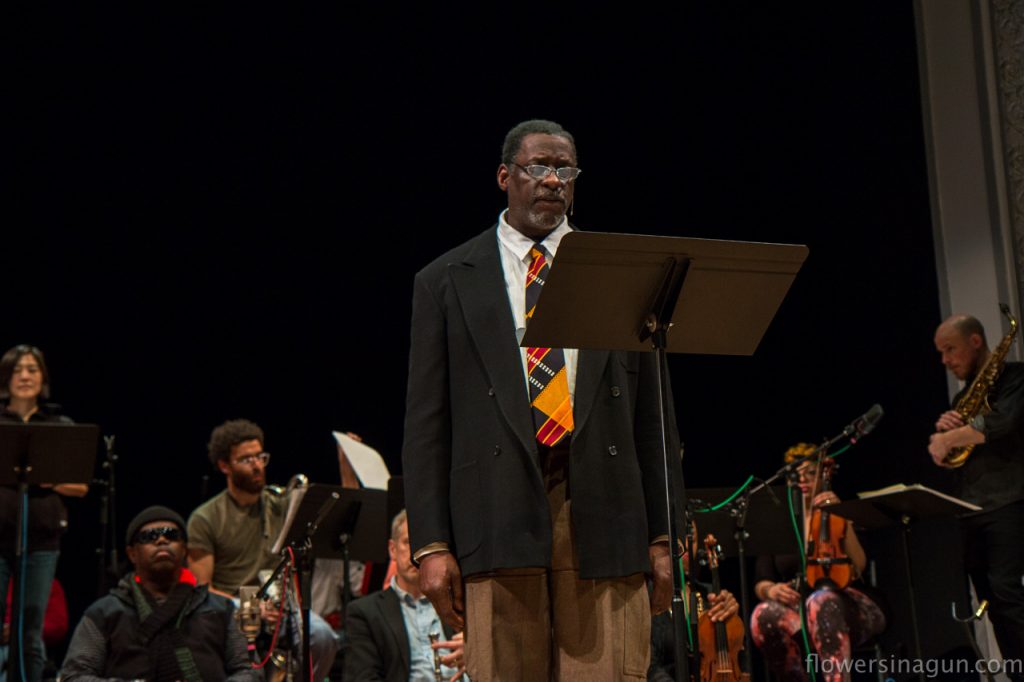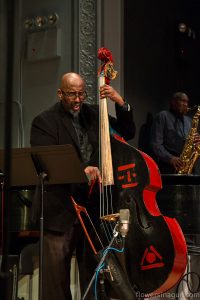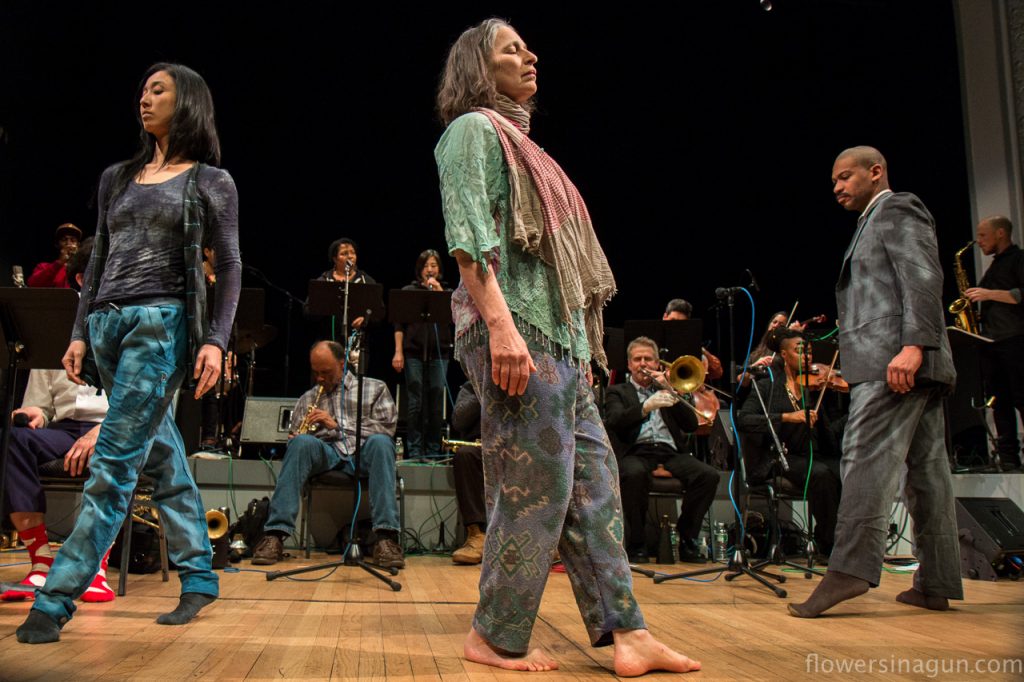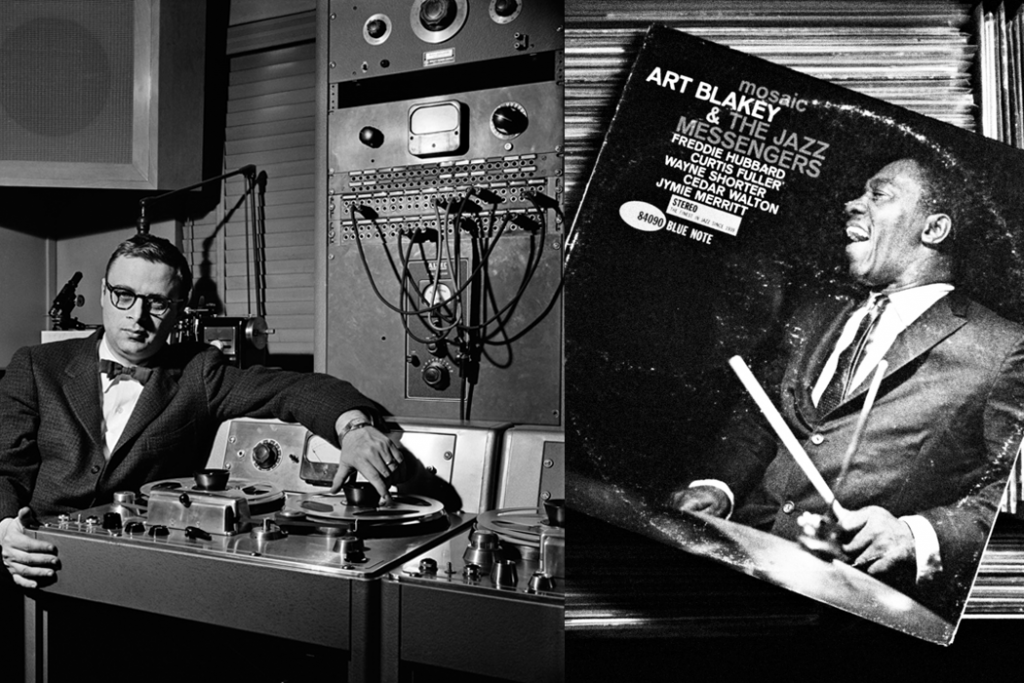
This past weekend, I was lucky enough to catch legendary jazz bassist William Parker and his “Tone Motion Theatre” hit Brooklyn’s Roulette for a free jazz celebration of Dr. Martin Luther King Jr. called Yes I Dream of Freedom.
It was basically a masterclass in how to execute a creative and thought-provoking concept piece, as Parker used music, dance, words and more to illuminate and comment upon MLK’s legacy and the changing dynamics of conversations about race, protest and society.
Before I go further, here’s a little background: “Tone Motion Theatre” is a veritable who’s who of free jazz and improvised music, with virtuosic musicians from New York, Philadelphia, New Orleans, Chicago, Australia and other places all coming together to perform. Yes I Dream of Freedom is the fifth movement of Parker’s extended work “Flower In A Stained Glass Window”.
The piece itself was a combination of composed music, text passages, improvisation and dance, all intended to pay tribute to Dr. King. It crosses time, geography, and physicality.
But the thing that made it really stand out was the way the performers were organized into tiny communities (you can see the full line-up at the bottom of this article). Each community, and musician, had a specific role to play within the parameters of the score—whether playing the score itself, improvising over the top, being given a solo, or being forced into silence without the ability to react for durations.
The magic of all this was that the Tone Motion Theatre was able to communicate their story not only through the words and notes they played, but with the choreography of the changing relationships and hierarchies within the overall group as they played. It seemed to present us with glimpses of the US in the 1960s, as different coalitions united, broke down, communicated and ignored each other in their efforts to achieve civil rights.
In essence, the performance was theatre, but without the actors. And I found myself watching the Shakespearean drama unfold with equal attention to the music itself. It was divided into two acts, which I’ll dive into in a little more depth.

Act I
It’s April 4, 1968. Dr. King has just been shot and is losing consciousness at St. Joseph’s Hospital in Memphis.
This is where Parker begins his performance, not in fact, but in dreamscape, with a brief overture featuring words spoken by the poet Larry Rowland (who plays Dr. King) and an interpretive dance laden with movements of ‘suspension’ and ‘ascension’ by Jason Jordan.
Parker uses this moment to set the tone for the evening wherein memory, reality, color, motion, words and sounds blend unpredictably and are expressed through the visions of Dr. King’s subconcious, accented by his dreamstate encounters with Lakota Indian warrior, Tašúŋke Witkó (aka Crazy Horse). It’s clear that the goal of the performance was not necessarily historical accuracy, but the turning of a blank canvas into a painting by the hands of Parker and King in collaboration.
“Who will pick up the baton and conduct the blind?”, repeats Rowland, as the gospel-style solo piano of Cooper-Moore turns quickly into a Duke Ellington-like explosion of rising chords and flaring brass solos piled on top of each other. Parker’s use of stage space is interesting as many of the improvising musicians were positioned on the left (loose) and the Transformational Music Ensemble who stuck strictly to the charts, sat off to the right (tight). As the band progresses, pieces drop off and eventually we’re left with a paired down club quartet playing what feels like My Favorite Things-era Coltrane on piano, bass, tenor sax and drums.
Parker moves us through some motifs representative of various African-American musical traditions fluidly, accenting each with texts that might ring true of the eras they were inspired by, recalling the widely held perspective amongst free jazzers that we should equate the freedom of political expression and civil rights advocacy with afrocentric, free improvised music (a perspective, perhaps popularized by artists like the Last Poets, Gil Scott Heron, Sun Ra and even Sonny Rollings and Billie Holiday).
As if it could’ve been predicted, vocalist Fay Victor chimes in with aggressive vocal whorls akin to Nina Simone, and before I can even blink an eye, the group shifts into a frenzied African free jazz lift, crescendoing urgently like the AACM. And then all becomes quiet. Cooper-Moore walks from the piano to his hand-made electric banjo. He plays a series of licks that seem to feather out from the delta blues pages of Robert Johnson or Lightnin’ Hopkins’ book.
In the span of ten high intensity minutes, the Tone Motion Theatre has painted 1960s portraits of uptown New York, underground Chicago, rural Texas and the sun-kissed plantations of Alabama.

Throughout the first act, soloists all over the stage stood up and spread their sound across the room ceremoniously. They were given space by the other members of the ensemble, they were given the floor and the talking drum. A respectful dialogue between speakers, players, held grasp of the audience, every voice unique and every utterance democratically heard. Shouts from across the stage echoed, “Give me back my drum!” Pretty soon, everyone was yelling it at each other, and just like that, the community started to unravel. You could sense the tension, the unrest and how hard one needed to now work in order to speak above everyone else, like at the Tower of Babel.
Communication and music are one in the same. Parker’s line “give me back my drum” simultaneously makes reference to the myriad of African cultural identities lost in the North American slave trade, and the notion of speaking through music (ie: the talking drum which imitates speech in parts of Africa).
Act 1 ends with an ashamed Rowland’s return to the stage. He utters quietly, “I shoulda told you to build your own drum.”
Act II
As I had the intermission to reflect on the first part of this performance, I remembered that one of Parker’s closest cohorts, someone who’s music and words have both touched and rallied thousands of people to the cause of civil rights and social change, Amiri Baraka, had passed away a year ago almost to the day. While the first act of Yes I Dream of Freedom was undoubtedly rooted in the cultures, events and lenses of the 1960s, perhaps the second act might be Parker’s opportunity to bring this conversation into the present, and reflect on some of the issues that we’ve been dealing with recently as a nation.
Surely enough, this was one of the routes taken, and if there was one voice whose words always seemed to wrap around any injustice in the last 30 years like a blanket of compassionate distrust, it was Baraka’s. I can’t help but think that this piece was in part, dedicated secretly to him.
What truly separated the second act of this piece from the first is the sense that an unfortunate chaos somewhat overcame that blissful harmony from the early moments of the night. The second act was larger, more intense and longer, and featured extended sections including up to around 15 improvising performers, singing and dancing all at once, leaving next to no room for comprehension of the spoken text. Had we been thrust into the throngs of the Vietnam War? It certainly felt like it. The message, the takeaway that every person in the room was left with, was a lingering question:
What happens when everybody talks and nobody listens?
Or, what if Dr. King never had a community around him that would listen, and what if he never listened to the voices around him?
A narrative flows throughout the texts of Yes I Dream of Freedom, aligning free improvised music with both nonviolent resistance and nonhierarchical community gathering, and suggesting that in order to really listen to one another, space must be made for each and every person to voice their opinion.
Parker’s piece is both a symbol of that bright harmony that can be achieved, and a cautionary tale reflecting what happens in our society when we let it break down. We can’t all be shouting at once and expect progress, sometimes even the leaders need to sit down and listen to the younger generation speak their mind.
This band, a multigenerational and eclectic family of musicians, composers, dancers, poets and beat-boxers, some band-leaders in their own right, did just that, expertly. Expert listeners become expert musicians.

At one point, nearing the end of the night, members of the ensemble began reciting and repeating the names of women and men who died in the name of freedom. Underneath, a tight piano, bass and drums trio rotated through some sombre chords, letting the names shine through louder than any word of poetry, speech or song had before in this room tonight.
There was a chilling moment shortly after Michael Brown’s name had been called out, when police sirens from outside on Atlantic Avenue in Brooklyn could be heard above the instruments. One by one, musicians took up their horns and added to the vamp.
In my life, I have never felt a pressure like this before, emanating from a music so full, so bloated with intense meaning and urgency, yet so spacious. It feels like the room is a pot boiling over, and all you can do is focus on what space there is left, what remaining air will be pressed out when the lid starts to rattle.
How much time do we have left? Or, if I were William Parker, I might ask, how little?

William Parker’s Tone Motion Theatre
Transformational Music Ensemble
Keir Neuringer (alto saxophone, musical director), Mike Watson (bass clarinet), Ryan Frazier (trumpet), Larry Toft (trombone), Veronica Jurkiewicz (violin/viola), Thomas Kraines (cello)
Spirit Catchers
William Parker (bass), Hamid Drake (drums), Steve Swell (trombone), Joe McPhee (trumpet, saxophones), Daniel Carter (reeds, trumpet), Cooper-Moore (piano, banjo)
Voices
Fay Victor, Kyoko Kitamura, Ana Ïsma Viel
Plus Larry Roland as Martin Luther King, Jr. and Nick Demeris as Tašúŋke Witkó (Crazy Horse).
Choreography by Patricia Nicholson, and dancers So Young An and Jason Jordan.
Special Guests
Marlon Jordan (trumpet), Jalalu Kalvert Nelson (trumpet), Alan Glover “Juice” (tenor sax), Mazz Swift (violin)
*Special thanks to Anna Yatskevich for her photos, she also wrote about the event, you can read her article here. And special thanks to Arts For Art, Inc., Jim Staley & Roulette.

